The question of how many galaxies there are in the universe is a complex one. Historically, astronomers have made attempts to determine the total number of galaxies in existence. However, counting them has proven to be a daunting task. As the numbers reach into the billions, the process becomes time-consuming. Additionally, the limited capabilities of our instruments pose a challenge. To capture the best possible images, telescopes must have a large aperture and be situated above the Earth’s atmosphere to avoid distortion caused by the air.
The Hubble Field: A Unique Glimpse into the Universe
The Hubble field is an extraordinary example that showcases the vastness of our universe. This mesmerizing image, known as the Hubble field, is a result of combining photographs captured over a decade from the renowned Hubble telescope. NASA has revealed that the telescope meticulously observed a tiny portion of the sky for an impressive 50 consecutive days. To put it into perspective, if you were to extend your arm and cover the Moon with your thumb, the deep field region would appear no larger than the head of a pin.
Through its meticulous collection of faint light over countless hours, the Hubble telescope has unveiled thousands of galaxies, ranging from those in close proximity to those situated in the farthest reaches of the universe. These awe-inspiring images captured by the Hubble telescope provide us with the most comprehensive and complete portrayal of the universe to date. Consequently, one can only begin to fathom the sheer magnitude of galaxies that exist beyond this minuscule patch of sky, hinting at the infinite wonders awaiting our exploration.
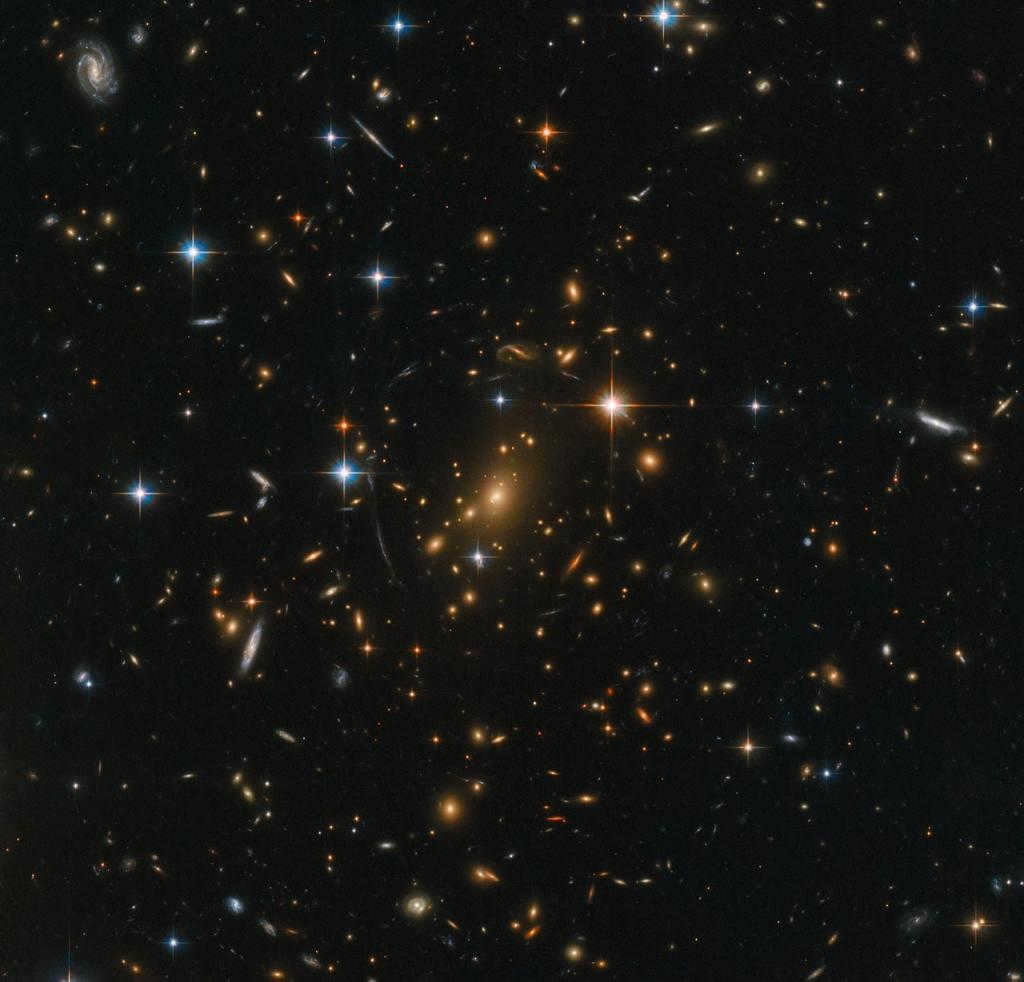
Opinions of experts
While there is some variation in the estimates provided by different experts, the answers to inquiries such as “What is the total number of galaxies in the universe?” can be conveyed using astronomical figures: between 100 and 200 billion. The launch of NASA’s James Webb Space Telescope in 2020 is anticipated to uncover further insights into the galaxies that existed during the early stages of the universe.
Technology is truly amazing. According to current knowledge from astronomers, the Hubble telescope is the most effective instrument for determining the quantity and estimation of the known galaxies in the universe. The telescope was sent into space in 1990 and initially had a flaw in its main mirror, which was fixed during a visit by a space shuttle in 1993. “Hubble” has also received various upgrades and maintenance visits until its final mission in May 2009. The question remains: is the universe infinite? How many galaxies and planets exist within it? It is highly likely that we will discover the answers in the future.
The Great Bear
In 1995, scientists directed their telescope towards an apparently empty area of the Great Bear constellation and collected data over the course of ten days. The outcome of this endeavor was the identification of roughly 3,000 faint galaxies in a single frame that had dimmed to a magnitude comparable to the 30th. To put this in perspective, Polaris has a magnitude of about second. This particular section of the image was designated as the Hubble Deep Field and represented the farthest observable point in the entire universe.
Once the aforementioned American telescope underwent a thorough modernization, astronomers conducted the same experiment twice. In 2003 and 2004, researchers discovered approximately 10,000 galaxies within a small area located in the Fornax constellation.
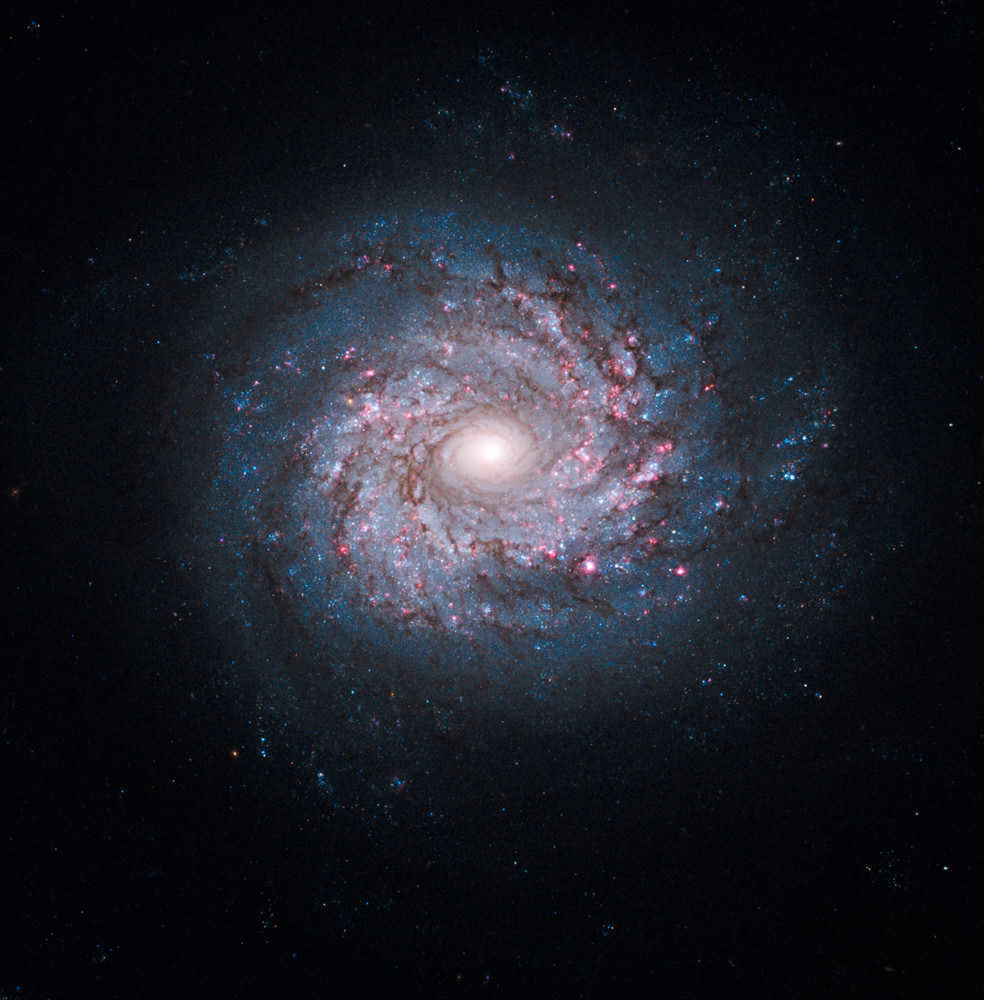
In 2012, once again utilizing upgraded equipment, scientists employed a telescope to observe a specific area of the ultra-deep field. Even in this more limited field of view, astronomers were able to identify approximately 5,500 galaxies. The scientists referred to this as an “extraordinary deep field.”
Innumerable Entities
Regardless of the instrument utilized, the technique for estimating the number of galaxies in the universe remains largely the same. A section of the sky captured by a telescope (in this case, the Hubble) is taken into consideration. By employing the ratio of this portion of the sky to the entire expanse of the universe, one can ascertain the total number of galaxies present in the universe.
The Cosmological Principle and the Age of the Universe
An example of the cosmological principle in the exploration of the universe is the detection of the cosmic microwave background – a form of radiation that serves as a trace of the early stages of the universe following the occurrence of the Big Bang.
By analyzing the movement of galaxies moving away from us, scientists have been able to measure the expansion of the Universe, determining its age to be approximately 13.82 billion years. However, as the Universe continues to age and grow larger, galaxies will gradually move farther away from Earth, making them increasingly difficult to observe.
It is worth noting that the universe is expanding at a rate faster than the speed of light, although this does not violate Einstein’s speed limit as the expansion is a result of the universe itself and not of objects traveling within it. Furthermore, the expansion of the Universe is accelerating.
When we talk about the “observable Universe,” we refer to the part of the Universe that is visible to us. Scientists predict that in 1-2 trillion years, there will be galaxies that exist outside the boundaries of what we can currently observe from Earth.
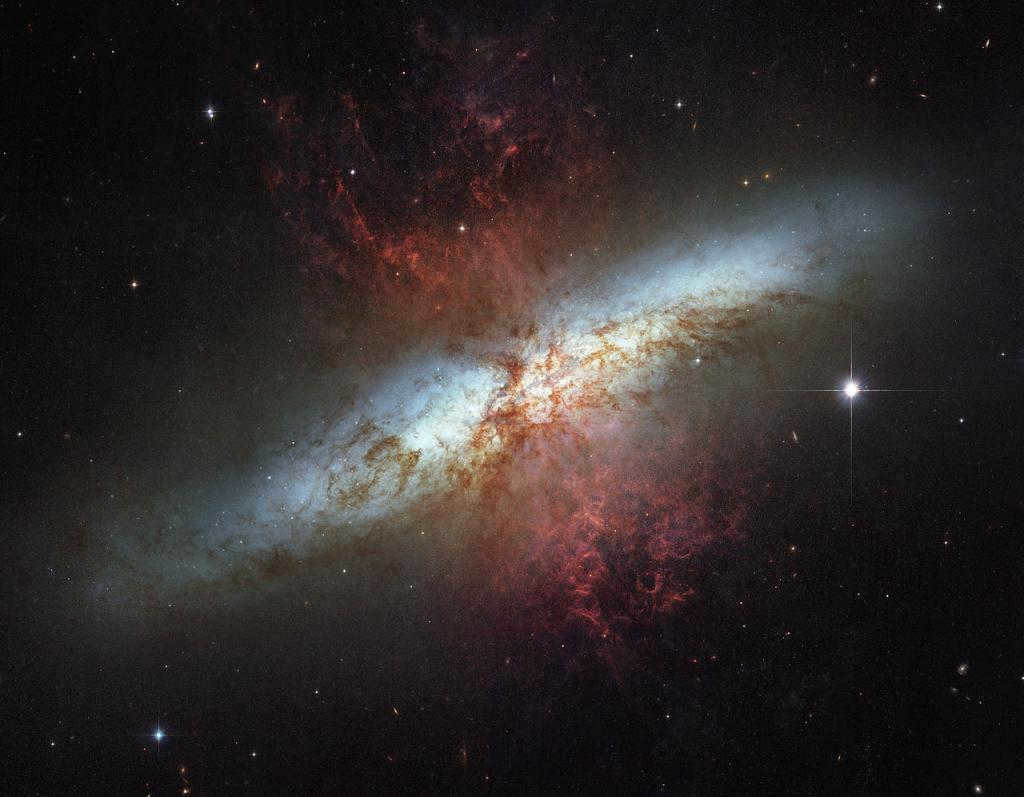
Modifying the light
The only light we are able to perceive is from galaxies that have traversed a sufficient distance to approach the Milky Way. It should be understood, however, that these entities do not comprise the entirety of the universe. This is why the term “observable universe” has been coined.
The destiny of the Milky Way
Galaxies, too, undergo transformations as time passes. The Milky Way is currently heading towards a collision with the neighboring Andromeda galaxy, and this cosmic encounter is expected to culminate in a merger in approximately four billion years. Subsequently, further galaxies within our local group will eventually converge. Experts in the field of astronomy anticipate that the dwellers of these forthcoming galaxies will bear witness to a dimmer cosmos.
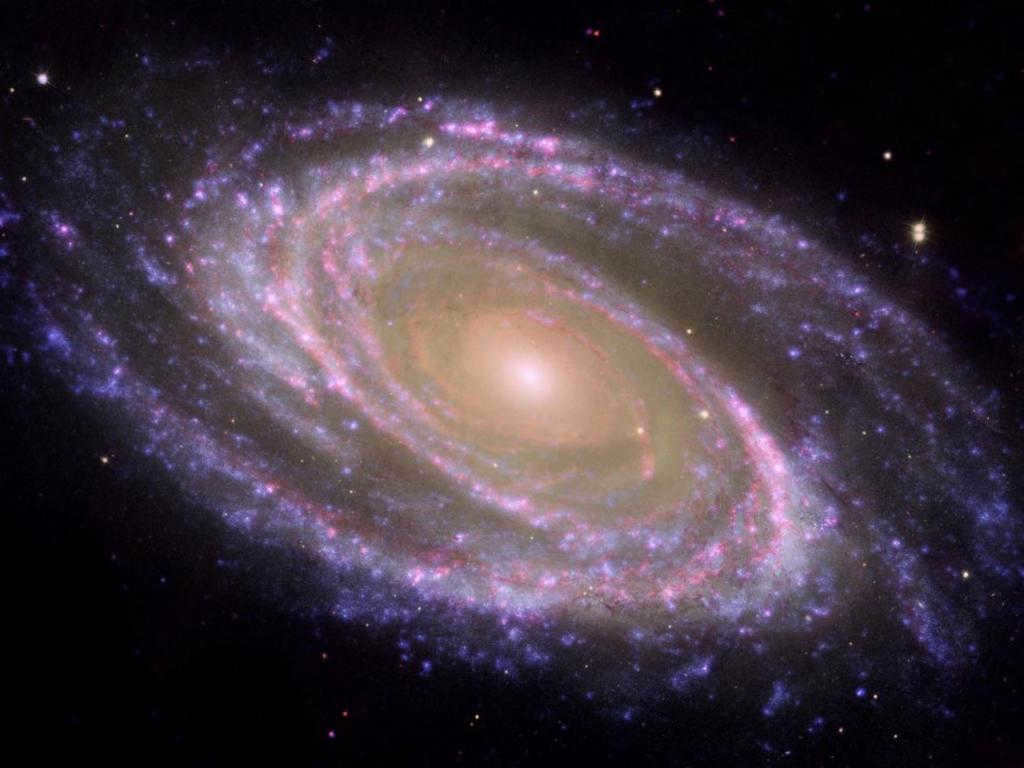
When ancient civilizations emerged, they lacked any evidence of a universe containing a hundred billion galaxies. Therefore, our future generations will not witness the expansion of the Universe. They may not even comprehend the occurrence of the Big Bang.
If we, as ordinary individuals, desire to comprehend the quantity of galaxies and planets within the Universe, astronomers are more focused on understanding the formation of the cosmos itself. According to NASA, galaxies offer a glimpse into how matter within the universe is organized – particularly on a grand scale. Scientists are also intrigued by the various types of particles and the principles of quantum mechanics at the microscopic end of the observable spectra.
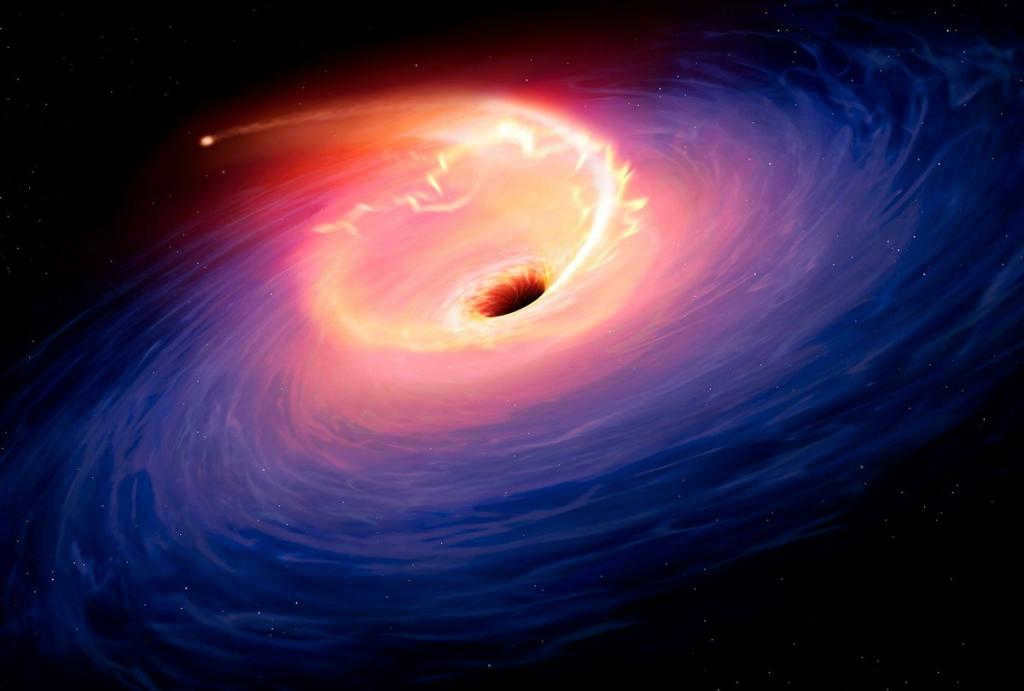
Origins of Early Galaxies
By examining some of the earliest galaxies and contrasting them with present-day galaxies, we can gain insight into their development and progression. Scientists will utilize an advanced telescope known as the Webb to gather information on the types of stars that existed in these primordial galaxies. Subsequent observations, involving spectroscopy of hundreds or even thousands of galaxies, will aid in comprehending the formation and accumulation of elements heavier than hydrogen, as well as the formation of star clusters throughout the centuries. Furthermore, these investigations will unveil the specifics of galactic mergers and provide illumination on numerous other processes.
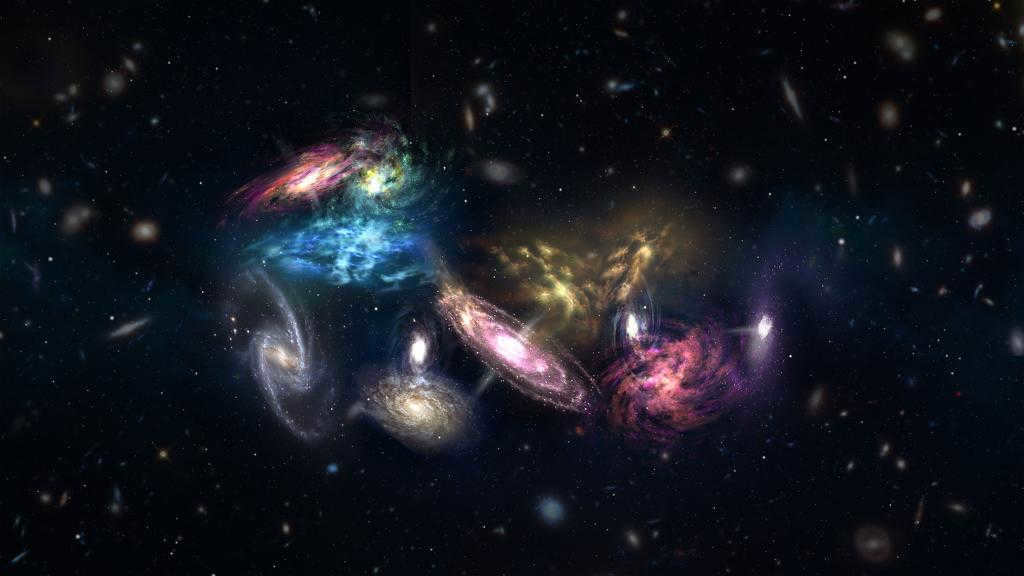
Dark matter
The nucleation of galaxies is an area of interest for scientists, who are also investigating the role of dark matter in this process. The question of how dark matter influences galaxy formation is an intriguing one. While galaxies and stars are visible parts of the universe, dark matter, which makes up the majority of the cosmos, remains invisible. The exact number of galaxies in the universe is still unknown, but it is certainly more than one hundred billion.
Summary
When gazing at the night sky and witnessing the vast expanse of stars and the Milky Way, one cannot help but feel insignificant in the face of the boundless Universe that lies beyond our reach. Although most of the Universe remains unseen to the naked eye, it is estimated that there exists an incredibly vast number of galaxies, stretching across billions of light-years in every direction.
Advancements in telescopic technology have allowed us to discover an increasing number of star clusters, from thousands to millions, and from billions to trillions. Based on the current state-of-the-art technology, it is estimated that there are approximately 170 billion galaxies in our Universe. However, it is believed that this number will continue to grow as we uncover more of these celestial objects, with some experts suggesting that there may be at least two trillion galaxies in total.
However, this approach will not be effective in practical terms. The capabilities of our telescopes are limited due to their size, which in turn restricts the number of photons they can gather. There exists a correlation between the visibility of faint objects and the extent to which a telescope can “survey” the sky. The presence of dark matter within the universe obscures certain regions. As objects become more distant, their visibility diminishes.
Consequently, our observations are confined to the illuminated portions of the universe, excluding dark matter, stars, and galaxies. Scientists have amassed data on numerous faint and remote celestial entities. They remain hopeful in their pursuit of discovering the true appearance of distant worlds. As mere spectators, we share in their fervent anticipation.
For many years, astronomers have been trying to figure out the number of galaxies in the observable universe, which is the part of space where we can see objects that emit light. Using images from the Hubble Space Telescope, scientists have estimated that there are around 100 to 200 billion galaxies in the universe we can see. However, our current technology only allows us to study about 10% of these galaxies. To observe the other 90%, we will need to develop larger and more advanced telescopes.
Professor Conselice’s team transformed specific images of the vastness of the cosmos captured by telescopes across the globe, with a particular emphasis on the Hubble telescope, into three-dimensional visualizations. This innovative approach enabled them to accurately measure the density of galaxies and quantify the volume of various localized regions within space. Through this meticulous investigation, the research team succeeded in identifying a significant number of previously undetected galaxies, akin to conducting an archaeological excavation on an intergalactic scale.
The findings of this research are derived from measurements of the quantity of observed galaxies at various epochs – distinct time intervals on a cosmic scale – throughout the timeline of the cosmos. When Professor Conselice and his team from Nottingham, in partnership with researchers from the Leiden Observatory at Leiden University in the Netherlands and the Institute of Astronomy at the University of Edinburgh, examined the population of galaxies at each epoch, they discovered that during an earlier phase of the Universe’s development, the abundance of galaxies was significantly greater than its current state.
It appears that during the early stages of the Universe, approximately a few billion years ago, there was a higher concentration of galaxies in a specific volume of space compared to the current period. Specifically, the number of galaxies was ten times greater in the past. These galaxies were primarily characterized by their low mass, similar to the galaxies that currently exist within the vicinity of the Milky Way.
According to Prof. Conselis, it is quite astonishing as our knowledge suggests that galaxies have grown in size over the course of 13.7 billion years since the Big Bang due to star formation and merging with other galaxies. The fact that there were more galaxies in the past indicates that there must have been a significant evolution that resulted in a reduction in their numbers through extensive merging of systems. The reason we are unable to observe the vast majority of galaxies is because they are faint and located at great distances. The number of galaxies in the Universe is a fundamental question in the field of astronomy, and it is astonishing to think that 90% of galaxies in space remain unexplored. It is intriguing to consider what fascinating characteristics we may discover when we study these galaxies using the next generation of telescopes.
Summary
The inquiry into the distribution of galaxy density in the Universe, as well as the total number of galaxies, is a crucial matter in astrophysics that has a significant impact on the resolution of numerous cosmological problems. Nevertheless, prior to the release of this research, there has not been a comprehensive study of this significant parameter, nor has there been a clearly defined algorithm for determining this quantity. In order to tackle this issue, we utilized observed galaxy stellar mass functions up to $z \sim 8$ to ascertain how the galaxy number density changes over time and at different mass thresholds. Our findings demonstrate that the increase in the overall density of galaxies ($\phi_T$) that are more massive than $M_* = 10^6M_\odot$ diminishes as $\phi_T \sim t^$, where t represents the age of the Universe. Additionally, we established that this trend reverses and instead increases with time at higher mass thresholds $M_* > 10^7M_\odot$. By utilizing $M_* = 10^6M_\odot$ as a lower threshold, we deduced that the total number of galaxies in the Universe up to $z = 8$ is: $2.0 \times >$ or simply $2.0 \times >$ (two trillion!). In other words, this is nearly ten times the number of galaxies observed in all Hubble Ultra-Deep Field-based sky surveys. We delve into the implications of these findings for comprehending galaxy evolution and compare our results with recent galaxy formation models. Moreover, these outcomes indicate that the cosmic background light in the optical and near-infrared likely emanates from these undetected faint galaxies. We also elucidate how these findings address the question of why the night sky is dark, which is also known as the Olbers paradox.
1. Introduction
When exploring the vastness of the universe and its characteristics, our curiosity often leads us to seek out the fundamental truths. For instance, it is a matter of great astronomical interest to determine the exact number of stars residing within our own galaxy, as well as the quantity of planets that orbit these stars (Fressin et al., 2013). Additionally, scientists strive to calculate the overall density of the universe as a whole (e.g., Fukugita & Peebles 2004), among other fundamental properties. In this study, we aim to provide a rough estimate for one of these inquiries: the total number density of galaxies and consequently, the grand total of galaxies in existence throughout the universe.
This question is not just an idle curiosity, but is relevant to many other inquiries in cosmology and astronomy. The distribution of galaxy density is connected to issues such as galaxy formation and evolution, the ratio of giant galaxies to dwarf galaxies, rates of distant supernovae and gamma-ray bursts, star formation rates in the Universe, and the creation and destruction of galaxies through mergers (e.g., Bridge et al. 2007; Lin et al. 2008; Jogee et al. 2009; Conselice et al. 2011; Bluck et al. 2012; Conselice 2014; Ownsworth et al. 2014). The number of galaxies in the observable Universe also provides information about the matter density of the Universe, the background light at different wavelengths, and the understanding of the Olbers paradox. However, there is still no accurate measurement of this fundamental quantity. Our ability to study the density distribution of galaxies using telescopes has only emerged with the advent of CCD cameras. Ultra-long-range surveys to search for distant galaxies began in the 1990s (e.g., Koo & Kron 1992; Steidel & Hamilton 1992; Djorgovski et al. 1995), and reached their current depth after Hubble Space Telescope-based projects, especially those such as the Hubble Deep Field (Williams et al. 1996). Further studies have been continued with the Hubble Deep Field South (Williams et al., 2000), the Great Observatories Origins Survey (Giavalisco et al. 2004), the Cosmic Assembly Near-infrared Deep Extragalactic Legacy Survey (CANDELS) survey (Grogin et al. 2011; Koekemoer et al. 2011), and topped by the Hubble Ultra Deep Field (Beckwith et al. 2006), which remains the deepest survey to date in the optical and near-infrared of our Universe.
However, despite all these studies, it is still unclear how the overall galaxy number density evolves over time. This is an interesting question because we know that the star formation rate increases and then decreases at z < 8 (e.g. Bouwens et al. 2009; Duncan et al. 2014; Madau & Dickinson 2014), while at the same time galaxies become larger and less distinctive (e.g. Conselice et al. 2004; Papovich et al. 2005; Buitrago et al. 2013; Mortlock et al. 2013; Lee et al. 2013; Conselice 2014; Boada et al. 2015). However, we do not know how the total number of galaxies changes over time and how this relates to the overall formation of the galaxy population as a whole.
There are several reasons why it is not easy to determine the total number of galaxies from ultra-long-range surveys. One is that all ultra-long-range observations are incomplete. This is due to limitations in exposure time and depth, causing some galaxies to be detected more readily than others. The result is an incomplete picture in even the most ultra-long-range surveys, which can be corrected, but which still leave some uncertainty. The more important problem, however, is that these observations do not reach the faintest galaxies, even though we know from theory that there should be many more faint galaxies beyond the limits currently available to us for observations.
It is also important to pay attention to what we mean by the total density of galaxies in the Universe. It is not a simple quantity that can be defined as the total density that currently exists, the total density that is observable in principle and the total density that can be observed with current technology are different questions with different answers. There is also the problem that we are limited by the cosmological horizon above what we can observe, and so there are galaxies that we cannot see beyond it. Even the number of galaxies that exist in the universe today, that is, if we could consider the entire universe as it is at the present moment, rather than being limited by the time of light travel, is a difficult question. Galaxies in the distant universe have evolved beyond what we can currently observe due to the finite nature of the speed of light and are likely to be similar to those in the visible universe. We address all of these issues in this paper, namely how the galaxy number density changes within the current observable universe up to z ~ 8.
For comparison purposes, in the Appendix of this paper, we also analyze the number of galaxies visible to modern telescopes at all wavelengths that we can currently observe. We then compare these data with measurements of the total number of galaxies that could potentially be observed in the Universe based on measured mass functions. We also discuss how these results reveal information about galaxy evolution and the background radiation of the Universe. We also provide information about future studies and what fraction of galaxies they will observe.
This paper is divided into several sections. §2 describes the data we use in this analysis, §3 describes the results of the present work, including methods for analyzing galaxy stellar mass functions to obtain the total number of galaxies in the Universe, §4 describes the implications of these results, and §5 presents a summary of the paper. In this paper we use the standard cosmology: H0 = 70 km s -1 Mpc -1 , and Ωm = 1 – Ωλ = 0.3.
2. Data
The second section of the report is dedicated to data.

Figure 1. We have represented the mass functions using the Schechter luminosity function in this research. All the values we used are obtained from the various studies mentioned in §2. The mass functions are plotted against cosmological redshift values, with the first graph depicting systems at z < 1, the second graph showing 1 < z < 3, and the third graph representing z >3 (far right). These mass functions are displayed in such a way that the solid colored lines represent mass functions up to the limit of the corresponding data in which they are complete, and the dashed lines indicate our extrapolation to $M_* = 10^6 M_\odot$. The mass function plot for 1 < z < 3 with the least steepness is derived from Muzzin et al. (2013), while the plot for z > 3 is obtained from Grazian et al. (2015).
3. Distribution of Galaxy Density
3.1 Introduction and Precautions
The primary approach we employ to determine the density of galaxies in the Universe involves integrating the number of galaxies using fitted mass functions for a given cosmological redshift. To accomplish this, we must extrapolate the fitted stellar mass functions to establish a minimum mass limit on the galaxy population. There are various methods available to achieve this, which we will discuss below. A key consideration is the lower limit at which we should start counting the number of galaxies based on the mass functions. Recent publications have provided stellar mass functions up to z ~ 8 (e.g., Duncan et al. 2014; Grazian et al. (2015), Song et al. (2015)), enabling us to perform this calculation for the first time. Another consideration is whether the Schechter luminosity function can be extrapolated below the data limit for which it was originally fitted. We will thoroughly explore this issue.
This complements the directly observable approach outlined in the Appendix and offers a more precise means of measuring the number of galaxies in the presently observed Universe, provided the mass functions are accurately measured and parameterized. However, this method carries potential pitfalls that necessitate careful consideration and analysis. One reason for this is that the measurements rely on more factors than just photometry and the inherent challenges in identifying objects when quantifying the number of galaxies. This situation is connected to other uncertainties associated with measuring stellar masses and redshifts. Nevertheless, if we can account for these uncertainties, integrating the fitted mass functions can reveal the densities of galaxies within a given redshift range with a certain level of measured uncertainty.
We employ this method to calculate the overall density of galaxies within the presently observed Universe as a function of redshift. To achieve this, we do not directly integrate the observed mass functions, but instead utilize a parameterized form based on the Schechter (1976) function to determine the total number density of galaxies as a function of redshift. The form of this function is as follows:
$\phi(M) = b \times \phi^\ast \ln(10) \times \exp[-10^] . . . . . . . .(1)$
where b = 1 for the mass function, b = 0.4 for the luminosity function, which will be expressed in absolute terms. For the mass function, $M^*$ represents the typical mass in logarithmic units and determines where the mass function changes slope, and $M = \log(\frac)$ represents the mass in logarithmic units. Similarly, for the luminosity function, $M^*$ corresponds to a typical magnitude. For both functions, $\phi^*$ is the normalization, and $\alpha$ determines the slope for fainter and less massive galaxies. Our approach utilizes the published values of $\phi^*$, $\alpha$, and $M^*$ to compute the integrated number of galaxies at various redshifts.
We employ the Schechter luminosity function as a means to calculate the overall density because it generally provides a good description of the mass distribution of galaxies across all redshifts within the ranges we investigate. However, we don’t know the lower mass limit at which it remains valid, which introduces some uncertainty into our analysis. Next, we discuss the adoption of $M_*>10^6 M_\bigodot$ as a limit and the reasoning behind its selection as our lower bound. We also consider how our findings would change if we were to use a different value for the lower mass limit constraint.
Since we are integrating mass functions over the entire history of the universe, we must utilize multiple surveys to account for the number of galaxies at different redshifts. Different redshift ranges require surveys conducted at different wavelengths, and occasionally different surveys yield varying values for the Schechter parameters. In this study, we aim to conduct a comprehensive analysis of mass functions that, particularly at low redshift, can produce significantly divergent density and evolution profiles. We obtain nearly identical results when employing the double Schechter luminosity function to calculate the mass function at low cosmological redshift, as well as when using the power-law to calculate the mass function at high cosmological redshift.
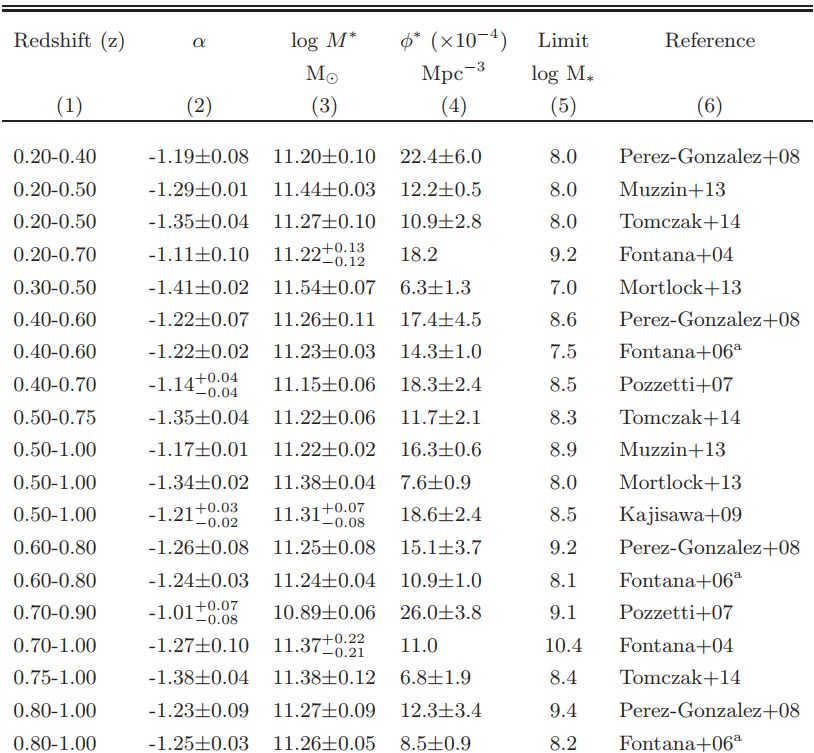
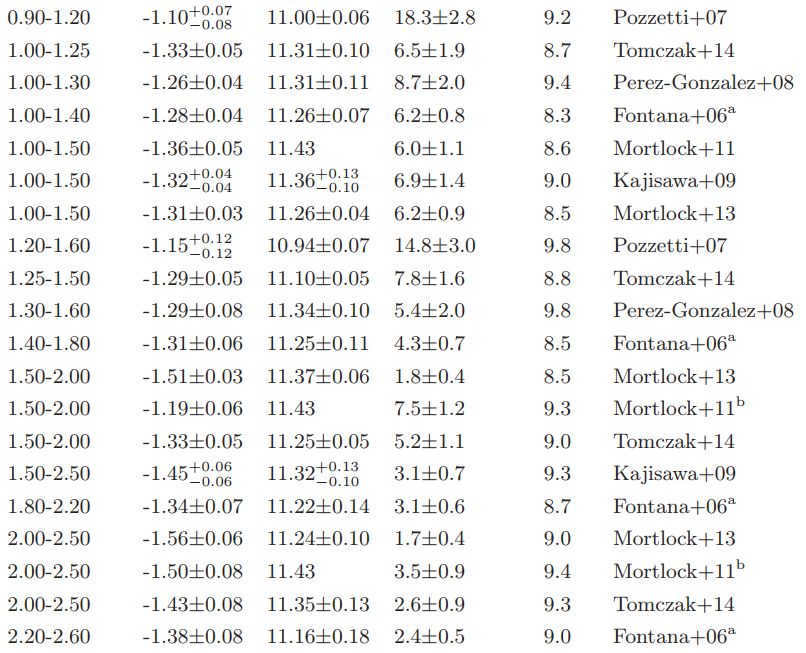
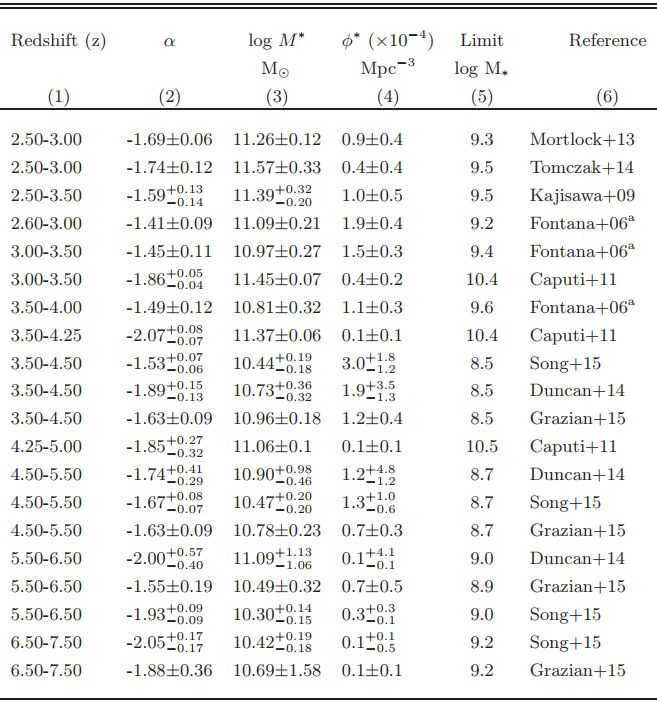
Table 1.
α Fontana et al. (2006) fitted the Schechter parameter variations based on redshift values, rather than individual redshift blocks. Therefore, these values are calculated using their formula for the parameters and their corresponding errors.
β Mortlock et al. (2011) utilized a constant M * of log M * = 11.43 throughout the cosmological redshift range they examined, from z = 1 to 3.
Note – This table presents the parameters of the reduced Schechter functions that we employ for our calculations. They are all normalized in order to achieve comparable values of the initial Salpeter IMFs, although Pozzetti et al. (2007), Duncan et al. (2014), and Mortlock et al. (2015) utilized initial Chabrier mass functions (Chabrier IMF), and Muzzin et al. (2013) employed initial Kroupa mass functions (Kroupa IMF).
Please note that we are only considering mass functions in which the parameter α in the applicable Schechter models is allowed to vary. If the mass function is calculated using a fixed value of α, it can distort the number of galaxies, as this parameter has a significant impact on the number of faint galaxies with small masses in a given volume (§3.2). Therefore, we are excluding the results of mass functions that use a constant value of α when modeling other Schechter parameters.
Recently, we have been able to study the earliest galaxies detected to date by measuring the stellar mass function for high cosmological redshift values up to z ∼ 8. We have used mass functions from studies conducted by Duncan et al. (2014), Grazian et al. (2015), and Song et al. (2015), which utilized observations from the GOODS-S field (Southern region) and GOODS-N field (Northern region) of the Great Observatories Origins Deep Survey (GOODS) program of the Cosmic Assembly Near-infrared Deep Extragalactic Legacy Survey (CANDELS), as well as from the Hubble Ultra Deep Field (HUDF).
For high cosmological redshift values, mass functions are a relatively new parameter. In order to obtain consistent and reliable data, we have also analyzed the derived luminosity functions in the UV, particularly at 1500˚A. We have used data published by Bouwens et al. (2011), McLure et al. (2009), McLure et al. (2013), Bouwens et al. (2015), and Finkelstein et al. (2015). McLure et al. (2013) and Bouwens et al. (2015) analyzed data from the most distant Hubble Space Telescope surveys, including the 2012 Hubble Ultra Deep Field survey HUDF12, which surveyed galaxies with the highest cosmological redshift values at $z = 8$ and $z = 9$.
To convert the stellar mass limit to the UV limit, we have used the ratios between these two quantities calculated by Duncan et al. (2014). Duncan et al. (2014) modeled the linear relationship between mass and light in the UV and how it changes at different cosmological redshift values. We have used these ratios to determine the UV limit corresponding to our standard mass limit $M_* = 10^6M_\odot$. This allows us to relate our stellar mass limit to the absolute magnitude limit in the UV. Although we do not use these values in our calculations, we have used these luminosity functions to verify the consistency of our results obtained from the stellar mass functions. We have found a high level of agreement with the stellar mass functions, even when using different variations of the conversion from stellar mass to UV luminosity (e.g. Duncan et al. 2014; Song et al. 2015). Additionally, all of our mass functions for high cosmological redshift values are more or less in agreement, except for Grazian et al. (2015), whose results lead to a slightly lower value of $\phi_T$.
5. Recap of the research
We have examined the fundamental issue of the distribution of galaxies in the Universe. We approach this problem from various angles and discuss the consequences for galaxy evolution and cosmology. By utilizing recently derived mass functions for galaxies up to z ∼ 8, we determine the distribution of galaxies in the Universe. Our primary finding is that the density of galaxies decreases over time, following a trend of $\phi_T(z) \sim t^$, where t represents the age of the Universe.
Subsequently, we explore the implications of this increasing galaxy density for a range of important astrophysical inquiries. Through integrating the galaxy density, we compute the total number of galaxies in the Universe, which amounts to $2.0 \times >$ for $z = 8$, and can potentially be observed. This figure is approximately ten times greater than the direct count, indicating the existence of a significant population of faint distant galaxies that remains undetected.
Regarding the astrophysical development of galaxies, we can demonstrate that the rise in the collective mass functions of all galaxies as redshift increases can be accounted for by the merger model. We can also illustrate that a basic merger model is capable of replicating the decline in the number of galaxies with a merger timescale of $\tau=1.29 ± 0.35 Gyr$. The calculated merger rate at z = 1.5 is approximately R ∼ 0.05 mergers $Gyr^ Mpc^$, which closely aligns with the value obtained through structural and pairwise analysis. The majority of these merging galaxies are lower-mass systems, progressively increasing from a lower threshold to higher masses in the overall density calculation.
In conclusion, we will explore the potential implications of our findings for future research endeavors.
In the coming years, with advancements in SED modeling and the collection of more comprehensive data from instruments like JWST and Euclid/LSST, we will have the opportunity to enhance our understanding of mass functions and obtain more precise measurements of the overall density of galaxies. This will provide us with a better grasp of this fundamental quantity.
© 2017 – 2023 The Timofey.pro website and all its content are protected by copyright law. Any unauthorized use, including copying, of the website’s materials, in whole or in part, is strictly prohibited. Violators will be subject to legal action.
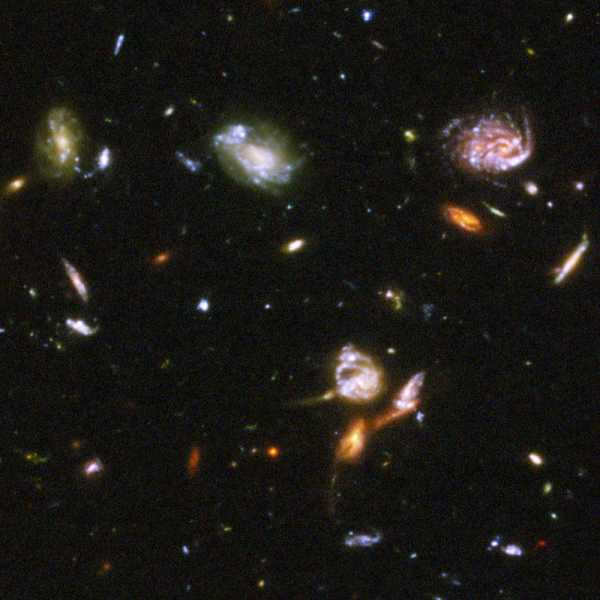

The image above is a part of the Hubble Ultra Deep Field image of space. It captures the vastness of the universe, showcasing numerous galaxies.
In the 1920s, the renowned astronomer Edwin Hubble made a groundbreaking discovery. He proved that our Milky Way is not the sole galaxy in existence. This revelation revolutionized our understanding of the cosmos. Today, it is a commonly accepted fact that the universe is brimming with thousands and millions of other galaxies. In comparison, our own galaxy appears minuscule. However, the exact number of galaxies near us remains a mystery. Today, we will uncover the answer to this intriguing question.
From One to Infinity
It may sound unbelievable, but our ancestors, even those who were highly educated in the sciences, believed that our Milky Way galaxy spanned the entire observable universe. This misconception can be attributed to the limitations of the telescopes available at that time. Even the most advanced telescopes could only capture galaxies as blurry spots, leading them to be commonly referred to as nebulae. It was thought that stars and planets formed from these nebulae over time, similar to how our own solar system came into existence. This hypothesis gained support with the discovery of the first planetary nebula in 1796, which contained a star at its center. As a result, scientists concluded that all other nebular objects in the sky were simply clouds of dust and gas that had not yet formed stars.
As expected, there was no lack of progress. In 1845, William Parsons constructed an enormous telescope called “Leviathan,” which was nearly two meters in size. His aim was to demonstrate that “nebulae” were in fact composed of stars, thus bringing astronomy closer to the contemporary understanding of galaxies. Parsons was the pioneer in observing the spiral structure of individual galaxies and identifying variations in their luminosity that corresponded to exceptionally large and brilliant star clusters.
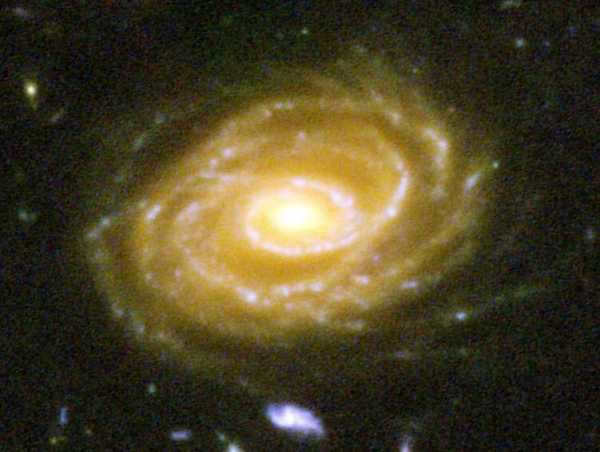

Galaxies can appear blurry even in images captured by advanced space telescopes.
However, the discussion persisted well into the 20th century. While progressive scientific society acknowledged the existence of multiple galaxies beyond the Milky Way, official academic astronomy required undeniable evidence to support this claim. As a result, telescopes from various locations around the globe focused their lenses on the Andromeda Galaxy, which was previously mistaken for a nebula, in order to gather this conclusive proof.
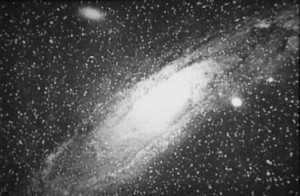
The original photograph of the Andromeda galaxy was taken in 1888.
A contemporary image
In 1924, utilizing the groundbreaking telescope of the early 20th century, Edwin Hubble successfully estimated the distance to the Andromeda galaxy with a reasonable degree of accuracy. It was discovered to be so vast that it completely ruled out the possibility of the object being part of the Milky Way (although Hubble’s estimate was three times smaller than the current one). The astronomer also observed numerous stars within the “nebula”, providing clear evidence of Andromeda’s galactic nature. Despite facing criticism from his colleagues, Hubble presented his findings at the 1925 conference of the American Astronomical Community.
This presentation marked the beginning of a new era in the field of astronomy – researchers “rediscovered” nebulae, renaming them as galaxies, and uncovered previously unknown ones. Hubble’s groundbreaking findings, such as the detection of redshift, played a crucial role in their advancements. The development and launch of cutting-edge telescopes, including the widespread adoption of radio telescopes post-World War II, contributed to the expanding knowledge of galaxies.
Nevertheless, it wasn’t until the 1990s that humanity acquired knowledge about the actual count of galaxies encircling us. The Earth’s atmosphere hampers the ability of even the most massive telescopes to capture a precise depiction – gas shells distort the image and absorb the starlight, obscuring the boundaries of the cosmos. Nonetheless, scientists have successfully circumvented these restrictions by deploying the Hubble Space Telescope, which is named after a familiar astronomer.
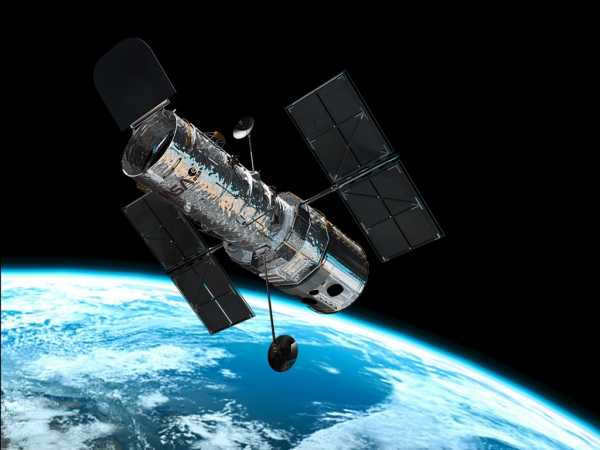
The Hubble Telescope, positioned in Earth’s orbit, has provided humanity with the groundbreaking ability to observe the dazzling disks of galaxies that were once mistaken for small nebulae. This remarkable technology has also revealed that the seemingly empty expanse of the sky is actually teeming with billions of previously unknown galaxies – and this is not an exaggeration. However, further investigations have unveiled that the number of stars visible to the Hubble Telescope, which is in the thousands of billions, is merely a fraction of their true quantity.
The ultimate count
However, the question remains: how many galaxies actually exist in the vast expanse of the Universe? I must caution you that this will require a joint effort – inquiries of this nature typically hold little significance for astronomers, as they lack scientific merit. While they do catalogue and monitor galaxies, it is primarily for broader objectives such as comprehending the cosmic framework on a grand scale.
Nevertheless, it is an impossible task to determine the precise quantity. In the first place, our universe is boundless, thereby presenting a challenge to compile a comprehensive record of galaxies, which is both problematic and unfeasible. Secondly, even if an astronomer were to dedicate their entire life to the task of counting the galaxies within the observable universe, it would prove insufficient. Assuming an average lifespan of 80 years, from the moment of birth, and allotting no more than a single second to identify and document each galaxy, the astronomer would only manage to identify slightly over 2 billion entities – a mere fraction of the actual number of existing galaxies.
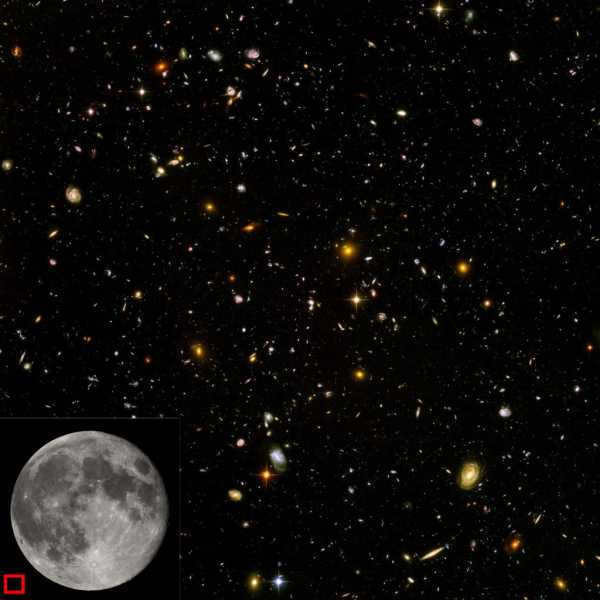
The Ultra Deep Field image provides a comparative scale for estimating the number of galaxies in the universe. In 2004, the Hubble Telescope captured this image, which covered an area equivalent to 1/130000000000 of the entire sky. Within this small area, the telescope detected approximately 10,000 galaxies. This finding was consistent with other deep surveys conducted at that time, suggesting an average of 130 billion galaxies visible within Hubble’s sensitivity.
However, the exploration of the universe did not end with the Ultra Deep Field image. Subsequent observations using various wavelengths, including infrared and X-rays, have revealed even more galaxies. As of 2014, scientists have identified a staggering number of 7 trillion 375 billion galaxies within a radius of 14 billion light-years.
However, once again, this is just a conservative estimate. Astronomers are of the belief that intergalactic dust clusters are responsible for obscuring 90% of the celestial objects we observe – so the initial count of 7 trillion easily balloons to 73 trillion. And this number will continue to increase exponentially when the James Webb telescope completes its orbit around the Sun. Unlike the Hubble telescope, which takes days to reach certain points, the James Webb telescope will cover the same distance in a matter of minutes, allowing it to delve even deeper into the vast expanse of the Universe.
The Universe encompasses all that exists. From the tiniest particles of cosmic dust to the massive, luminous stars; from the smallest hydrogen atoms to the intangible realm of subjective ideas and abstract concepts. Every single entity that occupies space and operates within it is an integral part of the vast cosmic tapestry that is the Universe.
The universe is the subject of study for a variety of scientific disciplines. Physics, astronomy, and cosmology are at the forefront of objectively exploring the cosmos. These fields strive to provide answers to questions about the composition of the universe and the number of galaxies it contains. In contrast, philosophy has long approached the study of the universe from a subjective perspective. As the oldest of all sciences, philosophy is less concerned with the quantity of galaxies and more focused on understanding how the universe and our perceptions of it impact our lives and personal growth.
Due to the immense magnitude of the Cosmos and the vast quantities of celestial bodies and matter contained within it, it is unsurprising that we have amassed an immense wealth of knowledge; likewise, it is not unexpected that numerous enigmas still elude us. At any given moment, only a minute portion of the Universe is within our physical reach, leaving the remainder to be conjectured. The past and future of the universe are mere suppositions and prognostications, while its present is accessible to us for a mere fraction of time.
Cosmos 8.93.
1980, USA, UK, TV series, season 1.
This is precisely the initial Cosmos featuring Carl Sagan, which was previously discussed in the segment about the film Cosmos: Space and Time. It held the top position in the realm of documentaries centered around outer space for quite a while.
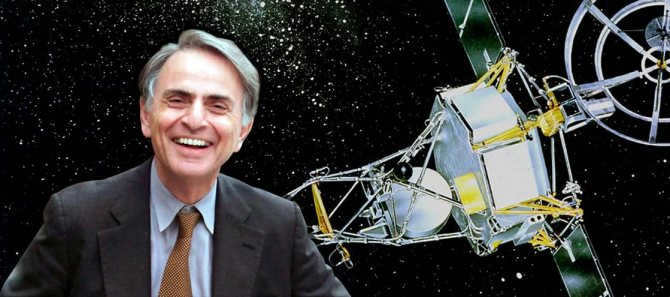

Everyone is familiar with Carl Sagan, who is widely recognized as one of the most influential astrophysicists of the latter half of the 20th century. Sagan dedicated his efforts to popularizing the field of astrophysics, a task at which he excelled. One of his most notable contributions to this endeavor was the creation of the renowned series “Cosmos,” which consists of 13 captivating episodes that explore the vastness of both the observable and unobservable universe.
Within this series, Sagan thoroughly covers a wide range of topics – from the moment of the Big Bang and the formation of stars and planets, to the origin of our Sun and the development of life on planet Earth. Even after more than 30 years since its initial release, “Cosmos” remains highly captivating and continues to capture the interest of viewers around the globe.
If you’re looking to challenge the status quo, if you’re a fan of this genre, or if you enjoy comparing the viewpoints of “professors” from different eras, then this is a must-watch!
What are the known facts about it?
We have complete certainty that the Universe is vast, and it can be confidently stated that it is immeasurable. To quantify the distances between celestial objects, a universally accepted unit is utilized – the light year. This unit represents the distance that light can travel in the span of one year.
The matter that comprises the Universe is located at a minimum distance of 93 billion light-years away from our planet. In comparison, our galaxy occupies a region that can be traversed in 100 thousand light years.
Scientists categorize cosmic material into a collection of atoms, the known and studied physical matter, also known as baryonic matter. However, a significant portion of the cosmos is occupied by uncharted dark energy, the characteristics of which remain a mystery to scientists. Additionally, a substantial portion of the visible expanse of the universe is taken up by dark or concealed mass, which scientists refer to as imperceptible matter.
The accumulation of baryonic matter gives rise to stars, planets, and other celestial bodies, which in turn shape galaxies. These galaxies are in motion and moving apart from one another. It is impossible to provide an exact answer to the question of how many galaxies exist in the Universe.
Great Bear
An exciting topic to explore would be: The fascinating history, daily life, and unique characteristics of the Olmec civilization
Back in 1995, astronomers directed their telescope towards what initially seemed to be an empty section of the Great Bear and meticulously recorded observations for a span of ten days. The outcome of this endeavor was the remarkable discovery of approximately 3,000 faint galaxies captured within a single frame, which appeared incredibly dim, measuring around the 30th magnitude. For comparison, Polaris has a magnitude of about two. This particular section of the image was subsequently named the Hubble Deep Field and went on to become the most distant field ever observed in the entire universe.
After significantly upgrading the aforementioned American telescope, astronomers conducted the same experiment twice. In both 2003 and 2004, scientists managed to identify roughly 10,000 galaxies within a confined area situated in the Fornax constellation.
In 2012, scientists once again utilized enhanced equipment to observe a portion of the ultra-deep field. Despite the narrower scope, astronomers managed to identify approximately 5,500 galaxies. This remarkable achievement was referred to as the “extreme deep field” by the researchers.
What is the subject of speculation?
The exact details of the universe’s past and the process of its formation are still uncertain. Scientists propose that the universe is approximately 14 billion years old and originated from the expansion of concentrated hot matter, known as the Big Bang Theory in cosmology.
It’s important to keep in mind that all of these models are theoretical, and there are many reasons why they cannot be tested in practice. As a result, it’s worth focusing on the knowledge that is currently available and proven, which can provide answers to questions such as the number of stars in a galaxy and the number of galaxies in the Universe. The Hubble telescope, which uses modern technology, has captured a photo known as the Hubble Ultra Deep Field, revealing the arrangement of numerous galaxies within a small visible portion of the sky.
Hubble Field
You may find the following topic interesting: What is Saffiano: its composition and uses
An example that highlights the aforementioned fact is the Hubble Field, an incredibly deep image created by combining photographs captured over a decade by the eponymous telescope. NASA reports that the telescope focused on a small section of the sky for a duration of 50 days. To put it into perspective, if you were to hold your thumb up to cover the Moon, the deep field area would be about the size of a pinhead.
By capturing faint light during numerous hours of observation, the Hubble telescope has identified thousands of galaxies, both near and incredibly far away. Consequently, the images taken by this telescope provide the most comprehensive depiction of the universe. Therefore, if this tiny portion of the sky already contains thousands of galaxies, one can only imagine the countless others that exist elsewhere in the universe.
You may find it fascinating: Alcohol Denat – what exactly is it: its formula, how it is obtained, its uses, and its effects on the body
Check out the PROGRAMMER’S DAILY Channel
Get insights into the life of a programmer and find intriguing reviews on various topics. Subscribe now to stay updated with the latest videos.
https://youtu.be/fQO8S63TtQc
What is a galaxy?
A galaxy is a collection of stars, gas, dust, and dark matter. The gravitational interaction between the visible matter and the mysterious dark matter binds a galaxy together into a tightly-knit group of celestial objects. Galaxies move at a specific velocity, which supports the theory of the expanding Universe, but the gravitational center of a galaxy remains unaffected by the overall motion of the Universe. All objects within a galaxy orbit around its gravitational center.
- elliptical;
- spiral;
- lenticular;
- lobed;
- irregular.
Galaxies are categorized as dwarf, medium, large, and giant based on their size. The exact number of systems and star clusters within a galaxy is uncertain, as it varies depending on factors such as the gravitational field of stars and the size of the galaxy.
Exploration: Journeying Across the Cosmos with Morgan Freeman 8.44
2010-2017, USA, Television Show, 8 seasons
Here we have an instance where a lavish undertaking is led by a renowned actor who may not possess expertise in the field, but is widely recognized. In this particular situation, we have the esteemed Morgan Freeman, known to audiences from his roles in “Escape from Shawshank”, “Seven”, and numerous other acclaimed films.
Indeed, his voice is renowned worldwide. It possesses a serene, gentle quality that is highly conducive to understanding, in short, perfect for a narrator behind the scenes. However, our audience remains indifferent towards it. As was previously mentioned in the case of Cumberbatch in the Stephen Hawking project, our viewers (unless, of course, they are willing to read subtitles or are fluent in English) will only hear the voice of the substitute or the voice-over translator. Nevertheless, Freeman’s evident aversion to the film in our country does not serve as effective advertisement.
Furthermore, the year 2017 is distinct from 2015. Over the course of two years, it is possible that new discoveries have been made!
Galactic proportions
Each galaxy consists of star systems, clusters, and interstellar clouds. Multiple neighboring galaxies can be drawn to one another and unite to create a local group. These local group clusters can contain anywhere from three to 30 galaxies of varying sizes and types.
Moreover, these local group clusters form massive star clouds known as superclusters of galaxies. The gravitational interdependence between galaxies in relation to their local group neighbors, as well as those in a supergroup, is contingent upon the interaction between baryonic atoms and concealed matter.
Open Space 8.31
2011, Russia, mini-series, 4 episodes of 51 min. each.
This time, we are presented with a remarkable four-part series about the space race, created by Russian filmmakers.
However, the focus of the series is not solely on the race itself. Instead, it delves into the fascinating milestones of space exploration achieved by Russian academicians and cosmonauts. Admittedly, certain aspects have been slightly smoothed over for dramatic purposes. Nevertheless, the series provides a unique opportunity to witness the progression of space exploration from the visionary works of Jules Verne and Tsiolkovsky to the present day (or, more accurately, the world premiere of the series in 2011).
All major catastrophes, all the ups and downs of aerospace engineering, and all notable space missions are documented in this endeavor. The reasons behind the discontinuation of the American program “Space Shuttle,” the deliberate sinking of the “Mir” space station, the veracity of American moon landings, the current absence of space exploration to the moon, and the failure to send the “Buran” spacecraft into space after its inaugural flight are just a few of the topics explored.
This project has a distinct focus on academia and astronauts, rather than exclusively on space, which adds to its inherent intrigue.
Milky Way
The Milky Way, our home galaxy, is a spiral disk with a lintel shape. The center of the galaxy consists of old stars known as red giants. The Milky Way is part of a local group that includes two nearby galaxies, the Andromeda Nebula and the Triangle Galaxy. This group is referred to as the Virgo Supergroup.
Within the local Milky Way group, there are approximately 40 smaller satellite galaxies. These dwarf galaxies are drawn to the stronger gravitational fields of their larger counterparts. It is believed that the Virgo Supergroup contains just as many black holes and dark matter regions as it does galaxies. While the precise number of stars in the Milky Way is unknown, the most accurate estimate is 200 billion. The diameter of the Milky Way spans one hundred thousand light years, with an average disk thickness of one thousand light years.
Space Station 3D 7.66
Released in 2002, Space Station 3D is a captivating documentary that takes viewers on a 47-minute journey through the wonders of outer space.
During the early 2000s, there was a growing trend in the film industry to produce movies in 3D technology. Space Station 3D was at the forefront of this exciting wave, utilizing state-of-the-art 3D technology to provide an immersive viewing experience.
However, it is important to note that the film can still be enjoyed in a traditional 2D format. Despite the absence of 3D effects, Space Station 3D remains a visually stunning and informative documentary.
Directed by Tomi Myers, the film takes place entirely on the International Space Station, offering a unique glimpse into the everyday lives of modern astronauts. From their daily routines to the breathtaking views of Earth from space, Space Station 3D showcases the remarkable experiences of those living and working aboard the ISS.
The Solar System
The Solar System is approximately 4.5 billion years old and has a disk-like structure. The Sun, located at the center, is the heaviest element in the system and holds the majority of its mass, resulting in a significant gravitational force. The eight planets that revolve around the Sun only contribute to 0.14% of the total mass of the Solar System. Earth is one of the four smaller planets in the Earth group, alongside Mars, Venus, and Mercury. The remaining planets are referred to as gas giants due to their predominantly gaseous composition.
Cosmos: Space and Time 9.03.
2014, USA, TV series, season 1
This TV series serves as a natural progression from a series that was created based on a screenplay written by Carl Sagan and others, way back in 1980.
However, it would be more accurate to say that this is an updated version of everything that was previously discussed in 1980. Over the course of the 34 years that have passed since the first series premiered, countless remarkable discoveries have been made.





